Significance of Comic Books (HW)
What is the significance of comic books as a narrative device in the novel? How do they mirror and comment on the larger story being told? How do they represent the power of storytelling and its ability to shape reality?
In Kavalier and Clay, comic books serve as a microcosm, a cartoon representation of the events happening in the real world intertwined with personal desires and emotions of Sam and Joe. For example, within the pages of the Escapist, Joe took out his anti-Nazi frustration on the Escapist's enemies, channeling his anger into every punch he inked. And while these cartoon punches did nothing to actually help the Allied cause, they helped relieve Joe's pain, as in his reality, the Anti-Nazi sentiment he portrayed in his comics was tangible and real. Ultimately, Joe wanted to emulate the anti-Nazi heroes of his comics, inspiring him to confront Carl Ebling, vandalize the office of the Aryan American League, and risk his life to kill the sole German stationed in Antartica. After leaving his family behind in war torn Europe, Joe lived vicariously through the Escapist and his other comic creations, inspiring him to take the actions he could to fight the Nazis, despite the global insignificance of these actions. This theme of Joe's personal emotions bleeding into his comic creations, and his comic creations rebounding to inspire him to jolt into action continues when Joe returns to New York and is isolated in the Empire State Building, where he drafts his epic graphic novel about the Golem. In this novel, a more sophisticated adult story, Joe poured his heart and soul into each page, as "Joe came to feel that the work - telling this story - was helping to heal him" (577). Joe's creation of the story was a way for him to let go of the baggage of his exhausting life, expressing his most concealed, deeply-hidden emotions. This healing process gave Joe the emotional rebirth he needed to return to Rosa, as "he had begun to tell himself that his not merely two-fold but two-step - that when he was finished with The Golem, then he would be ready to see Rosa again" (578). The comic book was not only an emotional outlet for Joe, but it drove the story forward and shaped Joe's reality, encouraging him to let go of his past and return to his family.
Now on to Sammy. For Sammy, comics serve as an outlet of expression for his subconscious desires, both regarding his homosexuality, and more prominently, his desire for a father figure. While Sammy was put on the witness stand and accused of portraying his homosexuality in the hero-sidekick relationships of his comic creations, he later recognized that Batman was not truly intended to be Robin's lover, but "he was meant to stand in for his father, and by extension for the absent, indifferent, vanishing fathers of the comic-book-reading boys of America" (631). Sammy's father, the Mighty Molecule, never played a consistent role in his life, and therefore Sammy expressed this subconscious depravity through his comic books.
So in the end it was fitting that the end of the Escapist coincided with the end of Joe and Sammy's escape, as the story being told through comics, the story inside the story, ended along with The Amazing Adventures of Kavalier and Clay.
In the end, comic books serve as a narrative device in the novel by serving as a lens into the hearts of Joe and Sammy, exposing their true desires and driving their actions many times without them even realizing.

Comments
Post a Comment